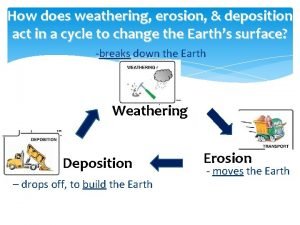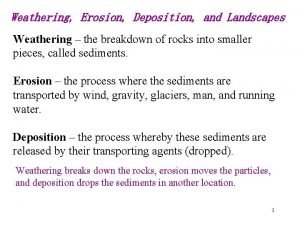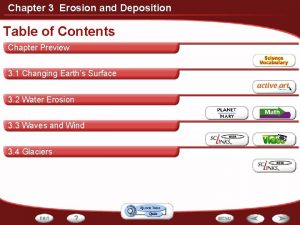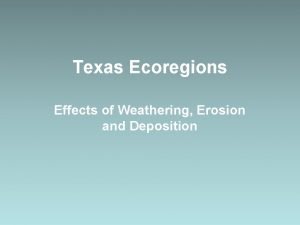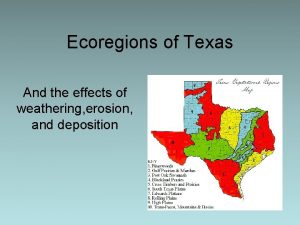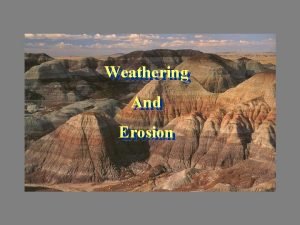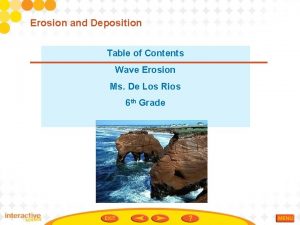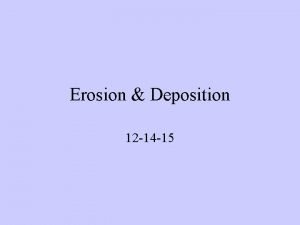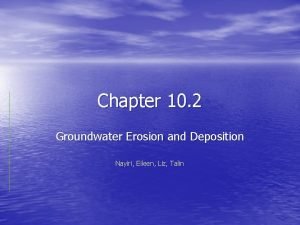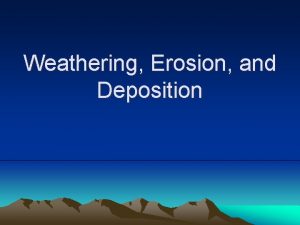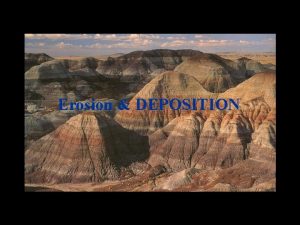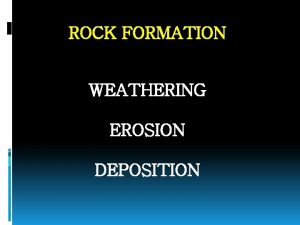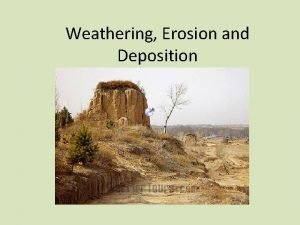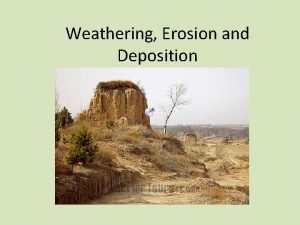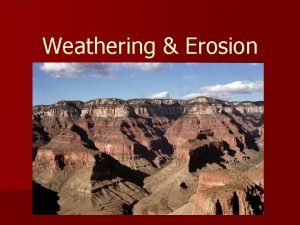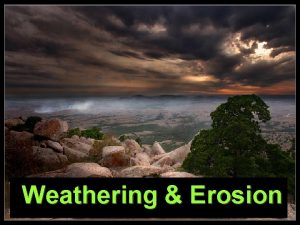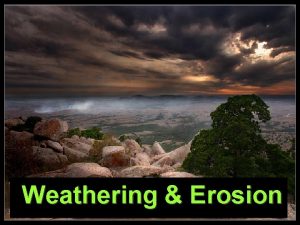Weathering Erosion Deposition Weathering is Weathering is the











- Slides: 11

Weathering, Erosion, & Deposition

Weathering is. . �Weathering is the breaking down of rocks into smaller and smaller pieces. �There are two types of weathering: � Mechanical Weathering � Chemical Weathering

Mechanical Weathering � Mechanical weathering is the breakdown of rock by physical means. � Some examples are: � Ice (Ice wedging/frost action is a series of freezing and thawing) � Abrasion (wearing away of rock by the mechanical action of other rocks) � Wind, Water, and Gravity are different forms of abrasion.

Chemical Weathering � Chemical Weathering is when rocks break down as a result of chemical reactions causing the composition of rocks to change. � Some examples are � Acid (found in water, precipitation or lichens) � Air (Oxygen reacts with iron in a process called Oxidation which forms Rust).

Rate of Weathering �Some rocks and minerals are more resistant to weathering, while others experience weathering more quickly. �Weathering happens more quickly in hot and wet climates. �Climate and rock type are the most important factors in the rate of weathering. �Weathering happens more quickly when there is more surface area. � For example, a pile of pebbles will weather more quickly than one large boulder.

Erosion �Erosion is the process through which soil and sediment are transported from one place to another. �Erosion is primarily responsible for the formation of river systems.

Wind Erosion �Wind erosion occurs when wind blows over sand. The sand is deposited when the wind hits an obstacle. � The process of wind erosion is called deflation. � The movement of wind erosion is a bouncing movement called saltation.

Wave Erosion & Glacial Erosion �Wave erosion occurs along shorelines. �Glacial erosion is the mass movement of glaciers.

Erosion and Gravity �Mass movement is the movement of material down a slope through gravity. � Examples: Landslide, Mudslide, Creep, Slump �Mass movement can occur quickly (landslide, rock falls) or slowly (creep).

Preventing Erosion �Soil is valuable because living things need it and fertile soil takes a long time to create. �To prevent erosion of valuable soil, we can plants to help hold the soil in place. � If plants are removed, a situation like the dust bowl in the 1930’s could take place. �Farmers will also leave the stalks of previous year’s crops to help hold the soil in place.

Deposition �Deposition is the process through which soil and sediment is dropped off or deposited. � Two examples of where this occurs are on beaches and at river deltas.
 Erosion in cross timbers
Erosion in cross timbers Erosion in trans pecos
Erosion in trans pecos Grade 2 science worksheets
Grade 2 science worksheets Weathering vs erosion vs deposition
Weathering vs erosion vs deposition Weathering erosion and deposition
Weathering erosion and deposition Weathering erosion and deposition post oak savannah
Weathering erosion and deposition post oak savannah Weathering erosion and deposition in texas ecoregions
Weathering erosion and deposition in texas ecoregions Difference between erosion and deposition
Difference between erosion and deposition How do waves cause erosion and deposition
How do waves cause erosion and deposition Diagram of erosion and deposition
Diagram of erosion and deposition Explain how water erosion by groundwater can form a cave.
Explain how water erosion by groundwater can form a cave. Groundwater erosion and deposition
Groundwater erosion and deposition


